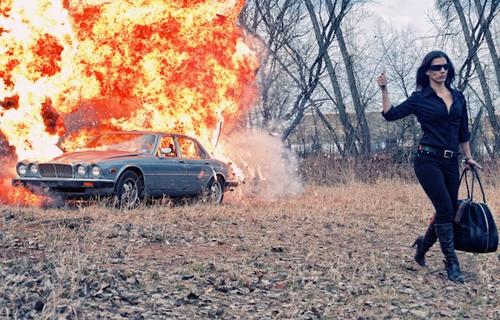Blowing Stuff Up and Other Hollywood Tech Tricks
From exploding cars to marauding dinosaurs to malevolent robots, we offer a peek at how the movie and TV industries do their special effects.
November 14, 2015
Movie and television special effects have become so good that we seldom stop to think about what’s behind them.
There is, however, a lot going on behind the scenes. Movie explosions, crashes, fire, wind, rain, and snow call for extensive planning and fabrication. Animatronics and digital effects require design, modeling, test, and validation. “It’s a make-it-happen business,” noted Drew Jiritano, founder of Drew Jiritano Special Effects, which has done movie and TV effects for more than 30 years. “Every day’s a challenge because so many effects are done only once.”
The challenges come in all shapes and varieties. Jiritano has been called on to blow up houses, cars, and boats. He has flipped countless vehicles and set men on fire.
The flip side of that mayhem is the task of breathing life into inanimate objects. On such films as Jaws and Jurassic Park, designers had to endow electronic dinosaurs and sharks with smooth lifelike movement.
In all cases, the key is planning and experience. “You have to remember -- it’s all fake,” Jiritano told us. “It looks bad and dangerous, but it’s always rigged up in a way that keeps us in control.”
Following are examples of special effects in the movies and on television. From exploding cars to marauding dinosaurs to malevolent robots, we offer a peek at how it’s done.
Click the image to start the slideshow.

Despite what Hollywood might have us believe, cars rarely blow up. To make it happen, special effects expert Drew Jiritano typically removes the car’s gas tank and interior, drains all its fluids, drills out the shock absorbers and takes out the battery. Then he places a tray of gasoline inside the hollowed-out vehicle and attaches “sand mortars” (metal tubes containing sand and pyrotechnics) to the doors, hood, and trunk. Finally, he adds cables to various parts, such as the doors, to tether them to the car’s body and keep them from turning into flying debris. Upon ignition, the gas tray creates a fireball, while the mortars launch the doors outward. Here, an actress detonates the explosives in a Jaguar while walking away from the explosion. “We always design it so that the mortars are only on one side,” Jiritano told us. “So the hood and trunk fly away from the talent.”
(Source: Drew Jiritano Special Effects)
READ MORE ARTICLES ON MOVIE TECHNOLOGY:
Senior technical editor Chuck Murray has been writing about technology for 31 years. He joined Design News in 1987, and has covered electronics, automation, fluid power, and autos.
Like reading Design News? Then have our content delivered to your inbox every day by registering with DesignNews.com and signing up for Design News Daily plus our other e-newsletters. Register here!

Design News will be in Orlando in November! Design & Manufacturing South will be in Orlando Nov. 18-19. Get up close with the latest design and manufacturing technologies, meet qualified suppliers for your applications, and expand your network. Learn from experts at educational conferences and specialty events. Register today for our premier industry showcase in Orlando.
About the Author(s)
You May Also Like
.jpg?width=300&auto=webp&quality=80&disable=upscale)


